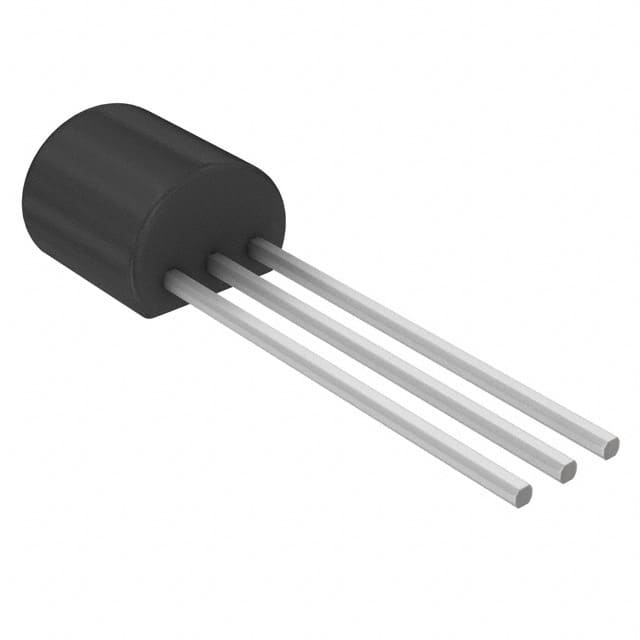Xem thông số kỹ thuật để biết chi tiết sản phẩm.

BC549BU Transistor
Product Overview
Category
The BC549BU transistor belongs to the category of small-signal NPN bipolar junction transistors.
Use
It is commonly used for amplification and switching of electronic signals in various applications.
Characteristics
- Low power, low frequency amplifier
- High current gain
- Low noise
- Suitable for general purpose switching and amplification
Package
The BC549BU transistor is typically available in a TO-92 package.
Essence
This transistor is essential for low-power electronic circuits requiring signal amplification or switching.
Packaging/Quantity
It is usually packaged in reels or tubes, with quantities varying based on manufacturer specifications.
Specifications
- Maximum Collector-Emitter Voltage: 30V
- Maximum Collector-Base Voltage: 30V
- Maximum Emitter-Base Voltage: 5V
- Continuous Collector Current: 100mA
- Power Dissipation: 500mW
- Transition Frequency: 150MHz
Detailed Pin Configuration
The BC549BU transistor has three pins: 1. Emitter (E) 2. Base (B) 3. Collector (C)
Functional Features
- Amplification of weak electronic signals
- Switching of electronic circuits
- Low noise operation
Advantages
- High current gain
- Low power consumption
- Versatile usage in various electronic circuits
Disadvantages
- Limited maximum voltage and current ratings
- Relatively low transition frequency
Working Principles
The BC549BU operates based on the principles of bipolar junction transistors, utilizing the control of current flow between its three terminals to amplify or switch electronic signals.
Detailed Application Field Plans
The BC549BU transistor finds application in various electronic circuits, including: - Audio amplifiers - Signal amplification stages - Switching circuits - Oscillator circuits
Detailed and Complete Alternative Models
Some alternative models to the BC549BU transistor include: - 2N3904 - BC547 - 2N2222 - BC548
In conclusion, the BC549BU transistor is a versatile component widely used in low-power electronic circuits for signal amplification and switching purposes. Its high current gain and low noise operation make it suitable for a range of applications, although its limitations in voltage and current ratings should be considered when selecting alternative models for specific circuit requirements.
Liệt kê 10 câu hỏi và câu trả lời thường gặp liên quan đến ứng dụng BC549BU trong giải pháp kỹ thuật
What is the BC549BU transistor used for?
- The BC549BU is a general-purpose NPN bipolar junction transistor commonly used for amplification and switching applications.
What are the typical operating conditions for the BC549BU?
- The BC549BU typically operates at a maximum collector current of 100mA, with a maximum collector-emitter voltage of 30V.
Can the BC549BU be used for audio amplifier circuits?
- Yes, the BC549BU is suitable for low-power audio amplifier circuits due to its moderate gain and low noise characteristics.
Is the BC549BU suitable for switching applications?
- Yes, the BC549BU can be used for low-power switching applications such as signal routing and control.
What are the key parameters to consider when using the BC549BU in a circuit?
- Key parameters include the collector current, collector-emitter voltage, base current, and power dissipation to ensure proper operation and reliability.
Are there any common alternative transistors to the BC549BU?
- Yes, alternatives include the BC547, BC548, and 2N3904, which have similar characteristics and can be used as substitutes in many applications.
Can the BC549BU be used in high-frequency applications?
- The BC549BU is not optimized for high-frequency applications due to its moderate transition frequency, but it can still be used in lower frequency circuits.
What are the typical gain characteristics of the BC549BU?
- The BC549BU has a moderate DC current gain (hFE) ranging from 110 to 800, making it suitable for various amplification tasks.
Does the BC549BU require a heat sink in high-power applications?
- Yes, in high-power applications, a heat sink may be necessary to dissipate heat and prevent the transistor from overheating.
Where can I find detailed specifications and application notes for the BC549BU?
- Detailed specifications and application notes for the BC549BU can be found in the manufacturer's datasheet and technical documentation, as well as in electronics reference books and online resources.

